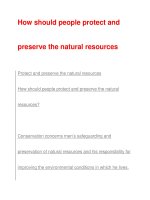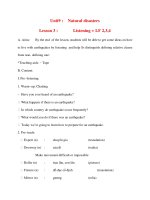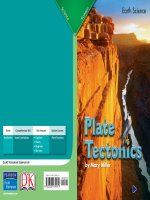4 10 using natural resources (earth science)
Bạn đang xem bản rút gọn của tài liệu. Xem và tải ngay bản đầy đủ của tài liệu tại đây (3.22 MB, 10 trang )
Earth Science
by Martin E. Lee
Genre
Nonfiction
Comprehension Skill
Cause and Effect
Text Features
•
•
•
•
Captions
Labels
Diagrams
Glossary
Science Content
Natural Resources
Scott Foresman Science 4.10
ISBN 0-328-13886-X
ì<(sk$m)=bdi gj< +^-Ä-U-Ä-U
Vocabulary
What did you learn?
conservation
1. What are some materials that make up soil?
fossil fuels
Lee
2. How do we get by
and Martin
use solar E.
energy?
humus
3. How do Earth’s natural resources get used up?
ore
Using Natural Resources
4.
You read about two kinds of
natural resources, renewable and nonrenewable. On
your own paper, explain how these resources are alike
and different. Use examples from the book to support
your answer.
5.
Cause and Effect What causes rock to
become soil?
petroleum
recycling
solar cell
solar energy
Illustrations: 4, 5, 10, 11 Tony Randazzo
Photographs: Every effort has been made to secure permission and provide appropriate credit for
photographic material. The publisher deeply regrets any omission and pledges to correct errors called to its
attention in subsequent editions. Unless otherwise acknowledged, all photographs are the property of Scott
Foresman, a division of Pearson Education. Photo locators denoted as follows: Top (T), Center (C), Bottom
(B), Left (L), Right (R) Background (Bkgd)
Opener: ©Alan Schein Photography/Corbis; Title Page: (B) ©Sylvain Saustier/Corbis; 2 ©Layne
Kennedy/Corbis; 5 ©Deborah Kopp/Visuals Unlimited; 6 (CR) ©DK Images, (CC) Colin Keats/Courtesy
of the Natural History Museum, London/©DK Images, (B) ©Sylvain Saustier/Corbis; 8 (TR) ©Layne
Kennedy/Corbis, (B) ©Kevin Burke/Getty Images; 12 ©Charles E. Rotkin/Corbis; 13 (BL) Getty Images,
(BC) ©Carin Krasner/Corbis, (CR) ©Liz Hymans/Corbis, 15 ©Owaki-Kulla/Corbis
ISBN: 0-328-13886-X
Copyright © Pearson Education, Inc.
All Rights Reserved. Printed in the United States of America. This publication is
protected by Copyright and permission should be obtained from the publisher prior
to any prohibited reproduction, storage in a retrieval system, or transmission in any
form by any means, electronic, mechanical, photocopying, recording, or likewise. For
information regarding permissions, write to: Permissions Department, Scott Foresman,
1900 East Lake Avenue, Glenview, Illinois 60025.
3 4 5 6 7 8 9 10 V010 13 12 11 10 09 08 07 06 05
What are natural resources?
How Resources Are Used
We use natural resources to make what we need. We also use
natural resources for energy.
Natural resources are the materials we get from nature. Some
natural resources are living things, such as plants and animals.
Some resources such as soil, water, minerals, and sunlight, were
never alive. Air is an important natural resource. All natural
resources help support life on Earth.
Living things need natural resources. Plants must have air,
sunlight, soil, and water to grow. Plants and animals give
people the resources they need for food. Everything we eat, use,
or buy either is a natural resource or is made from one or more
natural resources.
Renewable Natural Resources
Earth has renewable and nonrenewable natural resources.
Renewable resources can’t run out. They can be replaced. Solar
energy is power that comes from the Sun. It is renewable. Air,
water, trees, and soil are also renewable natural resources.
Water is a renewable
natural resource.
2
3
Why Soil Is a Renewable Resource
Ingredients in Soil
Soil covers most of Earth’s land areas. Some animals and
plants make their homes in the soil. Animals and plants
provide food for other living things, including people. Soil is
a nonliving natural resource.
Soil is made of bits of weathered rock. Soil
contains humus. Humus is decaying plant
and animal material. Humus adds nutrients
to soil.
Some animals, such as prairie dogs,
dig entire towns under the ground. Tiny
organisms such as bacteria, fungi, worms,
spiders, and insects, also live in soil. They
break down plant and animal remains that
plants can use as food.
Different soils come from different kinds
of rocks and minerals. The amount of
humus in soil affects its color and how it
feels when you touch it. Soil samples from
different parts of an area can look and feel
very different.
How Soil Is Renewed
Rock breaks apart during weathering. Plant roots and ice
erode rock by breaking it into pieces. Wind and water carry
bits of rock and deposit them in new areas. After a long time,
broken rock becomes soil.
Plant roots cause
rock to crack.
More plants growing
weathers the rock
even more.
Topsoil is the
top layer of soil.
Subsoil is part soil
and part rock.
Larger plants
grow in the
soil that has
formed.
Bedrock is mostly
solid rock.
4
5
Properties of Soil
Each kind of soil has certain
properties. Topsoil has a lot of
humus and bits of weathered rock.
These bits can be different sizes.
Soil for Growing Plants
Plants grow best in soil with many nutrients. Sandy soil does
not hold nutrients. Clay can hold nutrients. But it is so hard
that most plant roots cannot spread very easily. The best soil
for plants has some clay, silt, sand, and humus.
Clay
Clay, Silt, and Sand
Soil as a Renewable Natural Resource
Clay is soil made mostly from
the smallest bits of broken rock. The
materials in clay make it different
colors. Red clay has bits of iron in it.
Silt is soil with slightly larger
particles in it. Silt feels smooth. Sand
is soil with even larger particles.
Sandy soil has bits of different
materials. Quartz is the most
common material in sand.
The color of sand depends on
what materials are in it. Some
sand is tan. Sand from volcanic
rock can be black.
Some plants can put nutrients back in soil. Plants that get
plowed under at the end of a growing season also renew soil.
Renewing just a few centimeters of nutrient-rich topsoil can
take 1,000 years. That same amount of topsoil can wear away
in only ten years.
6
Silt
Other Uses of Soil
Sand
Soil has many uses besides farming. Clay is used to make
tile, bricks, and pottery. Sand is used to make concrete, glass,
and other things.
7
How are resources used for
energy?
Renewable Energy Sources
People use energy in many ways. We use energy to run
machines, make heat, and grow food. We can use the Sun’s
energy without even trying. A room becomes warmer when
sunlight shines in.
Solar energy warms Earth. The air near Earth’s surface heats
up when it meets the warm ground. The cycle of heating and
cooling air makes wind energy. The Sun also powers the water
cycle by making water evaporate.
How We Use Solar Energy
A solar cell changes energy from the Sun into electrical
energy. Solar cells are put together to make large solar panels.
Fields of solar panels collect energy. Solar energy is changed
into electric energy or heat energy.
In a solar heat system, solar energy heats water. The heated
water runs through solar panels into a storage tank. A pump
forces the water into pipes. The hot water can be used to heat
buildings.
Energy from Flowing Water
Moving water has energy. Today people use this energy
to run machines that make electricity. Dams are built to control
how the water moves. Water forms a lake behind a dam. It
flows through gates in the dam when its energy is needed.
Solar panels take in energy from the
Sun. Solar cells in the panels turn the
energy into electricity.
8
9
Nonrenewable Energy Sources
Some resources are nonrenewable because they are used
up faster than they are put back naturally. Others cannot be
replaced at all. People use many nonrenewable resources for
energy. Ore is a nonrenewable resource. Ore is a rock that is
rich with minerals.
Fossil Fuels
Coal, natural gas, and oil are nonrenewable energy sources.
They are fuels that we burn for heat. Fossil fuels come from
organisms that lived long ago. The Sun is the source of energy
stored in coal, oil, and natural gas.
Petroleum is commonly known as oil. Petroleum is made
from ancient sea life. Bacteria, algae, and other organisms used
the energy in sunlight to live. Their bodies stored energy they
didn’t use. After they died, their remains fell to the ocean floor.
More and more dead organisms fell to the ocean floor.
They formed thick layers called sediments. Millions of years
passed. The heavy top layers pushed down on the lower layers.
Pressure, heat, and decay changed the remains. Chemicals in
the bodies of those tiny organisms turned into fossil fuels.
Thick layers of dead plants
were buried. Over time, the
layers turned into rock.
Today we remove
coal from the layer
of rock.
Swamps once
covered the land.
10
11
Impact of Fossil Fuels
How Resources Can Last Longer
Removing fossil fuels from under the ocean floor can harm
Earth. An oil spill can result from drilling under the ocean.
Oil spills kill sea life. Spills can also kill or harm living things
along the coast. Companies are working to make drilling safer
and cleaner.
Using fossil fuels also has unsafe effects. Air is polluted when
fossil fuels burn. Too much carbon dioxide in the air may lead
to global warming. Gases from burned fossil fuels can break up
in rainwater to form a weak acid. The acid falls to Earth as acid
rain. It can damage buildings. It can harm living things.
People use nonrenewable resources to meet most of their
energy needs. But as people need more energy, fossil fuels will
be used up faster than ever. Fuel costs will go up.
Water, air, soil, and trees are resources that help all living
things. We must use them carefully. We must not waste or
destroy them. It is hard to restore forests, soil, and fishing areas.
It costs a lot of money too. So does cleaning up polluted air,
water, and soil.
To help our fossil fuels last, we can
use less energy. We should also use
wind power, water power, solar
energy, and other renewable
energy sources.
This oil rig digs deep
into the ocean floor
to get petroleum.
Old tires can
be used to
make a wall.
Do you recycle paper? The
paper in a notepad may once
have been your newspaper.
12
13
Methods of Energy Conservation
Recycling
Conservation means using only what you need. When
you conserve, you use resources carefully and without wasting
them. You can cut back energy use in many ways. You can walk
or ride a bike to go short distances. For longer trips, you can
share rides with others. Turn off lights you don’t need.
Some cars and appliances use less energy to do the same
amount of work as others. Less energy is needed to heat
buildings that have good insulation. If we conserve energy, our
resources will last longer.
Recycling is saving, collecting, or using materials again.
Recycling helps us reuse raw materials. There are ways to
recycle glass, cardboard, aluminum, tin, paper, steel, and some
plastics. Look for the recycling symbol on containers before you
throw them away. It looks like three arrows chasing each other
around a triangle.
Nature provides many materials that support life. These
natural resources help us to live and grow. Some can be
renewed. Others will be used up someday. It helps all life on
Earth when people use natural resources wisely.
Nearly everything
in this car’s trunk
can be recycled.
The recycling symbol
shows materials that
can be reused.
14
15
Vocabulary
Glossary
conservation
conservation
fossil fuels
fossil fuels
humus
humus
ore
petroleum
ore
recycling
petroleum
What did you learn?
the act of using only the resources you need
without wasting them
nonrenewable resources that come from the
remains of organisms that lived long ago
bits of rich soil formed from the decaying
remains of living things
2. How do we get and use solar energy?
3. How do Earth’s natural resources get used up?
4.
You read about two kinds of
natural resources, renewable and nonrenewable. On
your own paper, explain how these resources are alike
and different. Use examples from the book to support
your answer.
5.
Cause and Effect What causes rock to
become soil?
a rock that is rich with minerals
solar cell
another name for the fossil fuel commonly
known as oil
recycling
solar energy
saving, collecting, or using materials again
solar cell
a device that changes energy from the Sun
into electricity
solar energy
energy that comes from the Sun
Illustrations: 4, 5, 10, 11 Tony Randazzo
Photographs: Every effort has been made to secure permission and provide appropriate credit for
photographic material. The publisher deeply regrets any omission and pledges to correct errors called to its
attention in subsequent editions. Unless otherwise acknowledged, all photographs are the property of Scott
Foresman, a division of Pearson Education. Photo locators denoted as follows: Top (T), Center (C), Bottom
(B), Left (L), Right (R) Background (Bkgd)
Opener: ©Alan Schein Photography/Corbis; Title Page: (B) ©Sylvain Saustier/Corbis; 2 ©Layne
Kennedy/Corbis; 5 ©Deborah Kopp/Visuals Unlimited; 6 (CR) ©DK Images, (CC) Colin Keats/Courtesy
of the Natural History Museum, London/©DK Images, (B) ©Sylvain Saustier/Corbis; 8 (TR) ©Layne
Kennedy/Corbis, (B) ©Kevin Burke/Getty Images; 12 ©Charles E. Rotkin/Corbis; 13 (BL) Getty Images,
(BC) ©Carin Krasner/Corbis, (CR) ©Liz Hymans/Corbis, 15 ©Owaki-Kulla/Corbis
ISBN: 0-328-13886-X
Copyright © Pearson Education, Inc.
All Rights Reserved. Printed in the United States of America. This publication is
protected by Copyright and permission should be obtained from the publisher prior
to any prohibited reproduction, storage in a retrieval system, or transmission in any
form by any means, electronic, mechanical, photocopying, recording, or likewise. For
information regarding permissions, write to: Permissions Department, Scott Foresman,
1900 East Lake Avenue, Glenview, Illinois 60025.
3 4 5 6 7 8 9 10 V010 13 12 11 10 09 08 07 06 05
16
1. What are some materials that make up soil?









